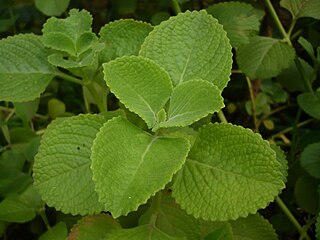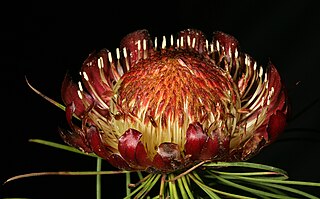
Nothofagus, also known as the southern beeches, is a genus of 43 species of trees and shrubs native to the Southern Hemisphere in southern South America and Australasia. The species are ecological dominants in many temperate forests in these regions. Some species are reportedly naturalised in Germany and Great Britain. The genus has a rich fossil record of leaves, cupules, and pollen, with fossils extending into the late Cretaceous period and occurring in Australia, New Zealand, Antarctica, and South America. In the past, they were included in the family Fagaceae, but genetic tests revealed them to be genetically distinct, and they are now included in their own family, the Nothofagaceae.

Coleus amboinicus, synonym Plectranthus amboinicus, is a semi-succulent perennial plant in the family Lamiaceae with a pungent oregano-like flavor and odor. The origin of Coleus amboinicus is unknown, but it may be native to Africa, and possibly India. Coleus amboinicus is widely cultivated and naturalized elsewhere in the tropics where it is used as a spice and ornamental plant. Common names in English include Indian borage, country borage, French thyme, Indian mint, Mexican mint, Cuban oregano, soup mint, Spanish thyme. The species epithet, amboinicus refers to Ambon Island, in Indonesia, where it was apparently encountered and described by João de Loureiro.

Cotoneaster is a genus of flowering plants in the rose family, Rosaceae, native to the Palaearctic region, with a strong concentration of diversity in the genus in the mountains of southwestern China and the Himalayas. They are related to hawthorns (Crataegus), firethorns (Pyracantha), photinias (Photinia), and rowans (Sorbus).

Banksia tricuspis, commonly known as Lesueur banksia or pine banksia, is a plant in the family Proteaceae and is endemic to a small area in the south-west of Western Australia. It is a stunted tree or shrub with narrow leaves and cylindrical spikes of golden-coloured flowers and it occurs in a geographic range of just 15 square kilometres near Jurien.

Carissa spinarum, the conkerberry or bush plum, is a large shrub of the dogbane family (Apocynaceae), widely distributed in tropical regions of Africa, Southern Asia, Australia, and various islands of the Indian Ocean. It is most well known in Australia, where it is also called currant bush or, more ambiguously, native currant or even black currant. It is, however, neither closely related to plums (Prunus) nor to true currants (Ribes), which belong to entirely different lineages of eudicots. In India, it is also called wild karanda /wild karavanda, referring to the related karanda. Carissa spinarum is often discussed under its many obsolete synonyms.

Phoenix reclinata, the wild date palm or Senegal date palm, is a species of flowering plant in the palm family native to tropical Africa, the Arabian Peninsula, Madagascar and the Comoro Islands. It is also reportedly naturalized in Florida, Puerto Rico, Bermuda and the Leeward Islands. The plants are found from sea level to 3000 m, in rain forest clearings, monsoonal forests and rocky mountainsides.
Alloxylon brachycarpum is a species of plant in the family Proteaceae. It is found in Indonesia and Papua New Guinea. It is threatened by habitat loss.

Campylospermum serratum is a plant in the family Ochnaceae. The specific epithet serratum is from the Latin meaning "with teeth", referring to the leaf margin. It is found in Tropical Asia, from Sulawesi, Indonesia to Hainan, Zhōngguó/China and over to southwester India. Gomphia serrata was a previous common name for the species. The plant is used for it wood and its sap is used in folk medicine and in the past for teeth-blackening.
Duguetia tobagensis is a small tree in the plant family Annonaceae which is endemic to Trinidad and Tobago. The species is only known from Tobago.

Lomatia tinctoria, commonly known as guitar plant, is a shrub to about 2 metres tall of the family Proteaceae. It is one of three species of Lomatia endemic to Tasmania, the others being L. polymorpha and L. tasmanica. Lomatia tinctoria is closely related to L. polymorpha, with which it sometimes hybridises. Its leaves are divided, while those of L. polymorpha are simple.
Chilocarpus is a genus of plant in the family Apocynaceae, first described as a genus in 1823. The genus is native to India, Southeast Asia, and New Guinea.
- Chilocarpus beccarianusPierre - Borneo
- Chilocarpus conspicuus(Steenis) Markgr. - Borneo
- Chilocarpus costatusMiq. - Borneo, Sumatra, W Malaysia, Thailand, Myanmar
- Chilocarpus decipiensHook.f. - Sumatra, W Malaysia
- Chilocarpus denudatusBlume - S India, Nicobar Islands, Indochina, Malaysia, Indonesia, New Guinea
- Chilocarpus hirtusD.J.Middleton - Borneo, Sumatra
- Chilocarpus obtusifoliusMerr. - Borneo, Sumatra, W Malaysia
- Chilocarpus pubescensD.J.Middleton - Borneo
- Chilocarpus rostratusMarkgr. - Borneo, Sumatra, W Malaysia, Thailand
- Chilocarpus sarawakensisD.J.Middleton - Sarawak
- Chilocarpus steenisianusMarkgr. - Borneo
- Chilocarpus suaveolensBlume - Borneo, Sumatra, Java
- Chilocarpus torulosus(Boerl.) Markgr. - Borneo
- Chilocarpus vernicosusBlume - Borneo, Sumatra, W Malaysia
Chilocarpus beccarianus is a plant in the genus Chilocarpus, in the family Apocynaceae. It is native to Borneo. It is an accepted species, first described by Jean Baptiste Louis Pierre and originally published in Bull. Mens. Soc. Linn. Paris, n.s., 1: 101 (1898).
Hypericum assamicum is a species of flowering plant in the St. John's wort family, Hypericaceae. It is endemic to India. Hypericum assamicum is one of two species of Hypericum in the section Hypericum sect. Sampsonia.

Hypericum przewalskii, commonly called Przewalski's St. John's wort, is a flowering plant in Hypericumsect. Roscyna that is native to China.
Saurauia klemmei is a species of plant in the family Actinidiaceae. It is native to the Philippines. Elmer Drew Merrill, the American botanist who first formally described the species, named it after Wilhelm Klemme, a German forest officer, who collected the specimen Merrill examined from Luzon island in the Philippines.

Protea pityphylla, also known as Ceres sugarbush or mountain rose, is a flowering shrub of the genus Protea, in the family Proteaceae. The plant is endemic to the southwestern Cape Region of South Africa.
Protea convexa, also known as large-leaf sugarbush, is a rare flowering shrub in the genus Protea of the family Proteaceae, which is endemic to the southwestern Cape Region of South Africa.
Protea decurrens, also known as linear-leaf sugarbush, is a shrub of the genus Protea, in the Proteaceae family, which is endemic to the southwestern Cape Region of South Africa. It is a small shrub with a thick underground rootstock, this structure throwing up numerous leafy branches, upon the base of which clusters of flower heads may appear close to the ground. It is pollinated by rodents and grows in low-altitude fynbos or renosterveld.
Combretum trifoliatum is a vine of the family Combretaceae. It is found from Myanmar across Southeast Asia and Wallacea to New Guinea and Australia. It grows in wet places, including where it can be submerged for 4 months a year by floodwaters. It is unusual in retaining its photosynthesizing leaves when flooded. Parts of the plant are used in traditional-medicine.
Helicia nilagirica is a tree of the Proteaceae family. It grows from Thailand across Mainland Southeast Asia to Yunnan, Zhōngguó/China and over to Nepal. It is a source of wood, a pioneer reafforestation taxa, and an ethnomedicinal plant.









